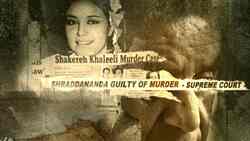Dancing On The Grave review: ‘Of Love and Other Demons’
Dancing On The Grave highlights the plight of a lonely princess in a hellish castle, whose skeletal remains are tossed and turned around to unearth the truth. ‘The truth’, however, is gravely elusive.
Apr 21, 2023

A poster of Dancing On The Grave
STORY: In the constant tussle between haves and have-nots in our society, are the rich always above the law and the poor, always vengeful and greedy? Patrick Graham’s docuseries Dancing On The Grave highlights the plight of a lonely princess in her hellish castle, whose skeletal remains are tossed and turned around to unearth the truth. The truth, however, is gravely elusive.
REVIEW: Who says lovers cannot render you lonely?
Inside the tall—and supremely elegant—mansions of the crème de la crème of 1980s Bangalore, there lived a stunner of a woman (Shakereh Khaleeli/ Namazie) who was married to a diplomat of the highest order, Akbar Khaleeli, and soon four beautiful daughters followed. But the illusion of perfection is shattered to pieces when ‘real love’ replaces luxury and intangible borders pertaining to religion are crossed for its sake.

The opening sequence makes it glaringly obvious that the victim in this four-part crime docuseries is outrageously wealthy, and distractingly good-looking to say the least. Well-spoken and immaculately dressed cousins and second cousins snap in and out of scenes at various intervals as re-enactments—coupled with vintage family footage—make up most of the heartbreaking story of the granddaughter of the former Diwan of Mysore.
To add context and relevance to Dancing On The Grave, the culprit Swami Shradhananda aka Murali Manohar Mishra, who was the second husband of Shakereh, is ushered in to present his version of what had transpired within the confines of the couple’s home. But the lack of depth and overall insensitivity of the man reduces his potential-clemency-plea to a mere desperate cry for pardon by media.
The docuseries is well-rounded and chronologically perfect in terms of laying the groundwork for the events that led up to Shakereh’s death. Perhaps because the docuseries looks at the socio-cultural aspect of this ‘rarest of the rare’ case through the tainted glasses of an outsider, both the religious angle as well as the class distinction prevalent in our society (which plays a key role in it, of course) gets only a fleeting mention. Former judges, ex-top cops and even a clinical psychologist seem to be leaning towards a certain side—I do not need to explain the details—and only a public defender makes a meek attempt to salvage the unsalvageable.
Dancing On The Grave—without a shadow of a doubt—is one of the better ones that fans of the Indian true-crime space are going to witness and enjoy.
And, to sum up the essence of the show, there’s a segment inside Sagar Central Jail with Swami Shradhananda that sent chills down my spine. A cat he is seen playing with, growls, and Shradhananda coldly asks, “Is this Shakereh’s ghost?” before breaking into a cynical laugh. In that moment, I realized—guilty or otherwise—why this man never danced his way to freedom in over 25 years.
VERDICT: If you have loved Netflix shows such as The Indian Predator and House of Secrets: The Burari Deaths, then the oddity of the case is reason enough for you to binge it this weekend.
Share
